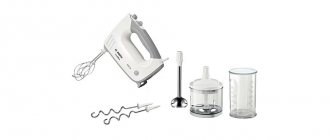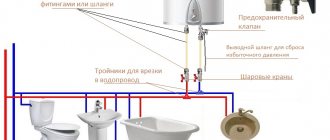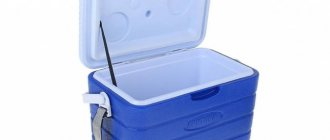Various construction works constantly require concrete - it is useful when pouring foundations, fence posts, erecting a barn, gazebo and other homestead buildings. It can be prepared by hand, but this takes a decent amount of time and effort. Many owners of private houses, and not just professional builders, have begun to purchase a concrete mixer in recent years. In principle, this is not surprising, since the solution obtained with this tool is approximately twice as strong as that prepared by hand.
In construction stores, the selection of concrete mixers is quite large. If you have never worked with such a tool before, then you will probably find yourself in a difficult position in terms of choosing such a device. We decided to help you cope with this problem and compiled a rating of the best concrete mixers in 2021. Here we will talk in great detail about the useful characteristics of the most popular products among buyers, and also give a number of tips that will certainly help you when purchasing this tool.
Rating of concrete mixers
Manufacturers offer concrete mixers equipped with electric motors. This technique is used in the construction of dachas and country houses, commercial real estate and industrial enterprises. Each facility has its own requirements for the equipment used, so concrete mixers are varied. Our experts selected models from well-known brands to compile a rating and assessed compliance with the stated parameters, performance, and reliability. The opinions of users and reviews of professional builders were taken into account.
The main attention was paid to the following features and characteristics:
- Operating principle – they produce forced-action concrete mixers and gravity models;
- Engine power – affects performance;
- Drum volume – determines how much mixture can be prepared in one batch;
- Material – manufacturers use steel, cast iron, impact-resistant plastic;
- The thickness of the drum walls affects durability and resistance to shock loads;
- Power supply – operating from 220 and 380V mains;
- Tipping - a steering wheel or lever is provided for unloading;
- Dimensions – equipment with low productivity should be convenient for transportation and storage.
Not all equipment could pass expert testing. Poor stability, engine power not matching the declared data, weak levers and drive gears - concrete mixers with such defects were excluded from our rating.
The best vibrating plates
Which concrete mixer should you prefer?
The toothed gear is the main element of girth-type concrete mixers, because It is she who activates the entire mechanism, encircling the drum of the device. Hence the conclusion that it is the crown material that is the fundamental selection criterion.
- Steel is durable and can withstand many hours of daily use.
- Cast iron products are very durable and at the same time remain affordable. But some fragility of the material does not allow the use of such models on an ongoing basis.
- Plastic units are quite cheap, they operate quietly, but their level of strength is minimal. Such devices will only be useful for small projects during home construction.
- Polyamide has excellent wear resistance. It is thanks to this nuance that such concrete mixers have become widespread.
The drive mechanism shaft is responsible for the movement of the pear in gear models. For this reason, you will have to pay attention to a number of the following characteristics:
- Power of the power plant. For a 12-hour continuous shift, an engine with a rating of at least 1 kW is suitable. If you plan to use it for a short time, then motors with a power of 500-800 W are suitable.
- Performance. In this case, the determining factor is the amount of solution that the machine is able to produce in one batch. However, the volume of the pear should also be taken into account.
- Drum wall thickness. This question is relevant for any type of units. This is due to the fact that over time the material wears out and is corroded by the solution. For non-professional purposes, a model where this figure does not exceed 2 mm is suitable. In other cases, more impressive characteristics will be required. However, it is worth noting that in the second case the weight will be higher.
Rate this post
The best concrete mixers up to 120 liters
When independently building a summer house, a house, or when performing repair work on a small site, a large drum volume is not required. The lifespan of the solution is limited, so a model for 80-120 liters is sufficient. Concrete mixers for home are small in size; the equipment can be brought into the room through a standard doorway. At the same time, the technology has good performance.
Bison Master BS-120-600
Designed for the preparation of solutions of small and large-sized fractions. Gravity type with a spacious drum in which you can prepare up to 60 liters of solution. The mixing blades have a special shape, and a powerful 600 W asynchronous motor rotates the “pear” at a speed of 27 rpm. This allows the mixture to be prepared within 2-5 minutes. The crown is made of durable, corrosion-resistant cast iron.
The drum body is made using pressing technology from sheet steel 2 mm thick and can withstand high static and dynamic loads. The drum is protected from corrosion by a polymer powder coating based on a polyester composition that is resistant to atmospheric influences. An electromagnetic switch with protection against accidental start-up is installed. The drum can be fixed at any angle.
Advantages:
- The engine does not require maintenance;
- Easy unloading;
- The blades are bolted;
- Fits in the trunk of a car;
- Extended warranty 5 years;
- A set of fasteners is included.
Flaws:
- Not detected.
Unlike most models, the articulation of the large gear and the drive shaft here is carried out not using a flat, but through a key. This protects the gear from turning under high loads and eliminates the possibility of grinding. As a result, service life is increased and operating costs are reduced.
Profmash B-140
The body is made of carbon steel sheet, 2 mm thick. The container is resistant to mechanical shock. Polyester-based powder paint provides good corrosion protection. The crown is made of glass fiber reinforced polyamide. The material is resistant to abrasion and has an increased service life. The polyamide crown is easy to replace, and in operation it has a minimal noise level.
The gear is connected to the drive shaft by welding. This reduces the risk of spinning under maximum load. The blades are bolted to the body, which reduces vibration. The steering wheel type tilting mechanism can be fixed in one of seven positions.
Advantages:
- Wheels on a wide axle;
- Large steering wheel diameter;
- Leg lock;
- Power supply from household power supply;
- Reliable electric motor.
Flaws:
- Short cable.
Kraton BeeTone 70
Compact electric concrete mixer for 220 volts, gravity type. Equipped with an economical asynchronous electric motor that drives a 65-liter capacity. In one batch you can prepare 46 liters. solution. The rotation speed reaches 27 rpm, which allows you to complete mixing within 3-6 minutes. The container is made of sheet metal with anti-corrosion coating.
The electric motor is reliably protected from dust, moisture, and mechanical impact by a housing made of impact-resistant plastic. Electrical wiring is double braided. Tilting the drum using a lever with a comfortable textured handle. The frame has wheels for moving around the construction site. The crown is made of durable cast iron alloy.
Advantages:
- Small sizes;
- Replaceable gear;
- Low noise level;
- Uniform mixing.
Flaws:
- The operating speed is noticeably reduced when fully loaded.
How to choose a concrete mixer
The question of which concrete mixer to choose for individual construction or for a professional team cannot be called rhetorical. Failure of this equipment will cause a slowdown in the pace of construction and the need to mix concrete manually. To prevent bloody calluses from appearing on your hands, it is recommended to choose a reliable concrete mixer. It is worth understanding the operating principle of the model you like, paying attention to the power characteristics, drum volumes and finished mixture. An important role is played by the material from which the crown, container, and equipment frame are made.
Gear or gear units
When choosing a gravity-type concrete mixer, it is recommended to look at the device that transmits torque from the motor to the drum. On sale you can find gear and crown units. Both options differ in price, operating method, as well as durability and reliability.
Geared models
The equipment is characterized by a free-standing gearbox, which is covered by part of the housing, so it is not exposed to sand and other particles. Such machines are considered more reliable and make less noise during operation, but require more careful use. If such a mechanism fails, repairs are not only expensive, but also difficult, and sometimes it’s easier to buy another concrete mixer.
Crown models
This technique is characterized by an open mechanism, since the crown is fixed around the drum. It is constantly exposed to the solution and its other components, so the degree of wear increases significantly, but the equipment is unpretentious in operation and replacement. Replacement and repair are very easy.
Often in everyday life and construction, concrete mixers are used, which are popular because of their simplicity and understandable technology, and maintainability. The parts are sold in any store with similar equipment, the crown can be easily ordered on the Internet, and you don’t need to call a repairman to repair it.
When choosing a crown, you should understand that the element comes from different materials, which will be responsible for reliability and service life:
- Cast iron. This material is used by many manufacturers for devices in the mid-price segment. A cast iron crown is easy to make, since everything is poured through a mold, and after cooling, the workpiece requires almost no additional processing. The price of raw materials is low, the production method is simple, so the cost of the finished crown is low, which is the main advantage. But such a product has many disadvantages. The material itself can easily break under mechanical influence, the teeth wear out over time, and a lot of noise appears. It is recommended to use equipment with this crown for rare and one-time use with a light load.
- Steel. This material for the crown is characterized by strength and reliability, as well as an average degree of abrasion. In addition, during an impact or fall, the steel does not burst, and the volume is several times lower. The main disadvantage is the inflated cost, since for production the steel is initially heated, after which it is poured into a mold and left to cool. After extraction, turning and polishing are carried out. All processes are expensive, this is reflected in the market price, but the product is strong and durable. Concrete mixers with a steel crown are recommended for working for several hours every day. The technique can be used indoors or outdoors.
- Plastic. Such crowns are considered the cheapest because they are easy to make. The main advantage is minimal weight and quiet operation. However, with use, the teeth wear out quickly. Concrete mixers with this element are recommended for purchase for small construction activities at home.
- Polyamide. A modern material that is lightweight and highly durable. Equipment with such crowns is produced recently; in addition, polyamide is not affected by temperatures, so loads in summer are allowed, the teeth are preserved, and there is no deformation. Moisture does not cause rust and there is no reaction to abrasives. Concrete mixers with polyamide crowns are ideal for every day of long-term use inside buildings or outdoors.
Any crown is a ring with teeth that are installed around the drum. With the help of the device, the drum begins to move. During operation, a concrete mixer creates friction and vibrations, which lead to abrasion of the teeth, so after wear, the part must be replaced.
Operating principle
They produce gravity and forced concrete mixers. The equipment is equipped with electric motors, but the mixing principle differs. In gravity models, the tank rotates, the blades mounted inside capture the solution, lift it up, after which, under the influence of gravity, the concrete falls and is picked up again by the blades. High intensity cycles ensure uniform mixing. The advantage is the need for a low power motor.
The forced-type device consists of a fixed container in which a central drive axis with blades is installed. The equipment operates on the principle of a classic mixer. The advantage is that the tank volume is not limited. Disadvantage: it requires a powerful electric motor that consumes a large amount of energy. For example, a 250-liter gravity installation consumes 800-1000 W, a forced installation consumes 5500-6000 W.
Power
Affects productivity, the ability to prepare a large volume of cement mortar in one batch. The ability to work as long as possible without stopping depends on power. When choosing, it is necessary to take into account the characteristics of the electrical network to which you plan to connect the equipment. For a holiday village, it is recommended to buy a model with a 700-1000 W electric motor. The operation of this equipment will not cause an emergency in the power supply system.
Drum volume
One of the main technical indicators. Must match the intensity of the construction team. A single master will produce 25-35 liters of masonry mixture in an hour (lifetime of the solution). For these purposes, you can purchase an inexpensive concrete mixer with a tank of up to 100 liters. A small team, consisting of a master and two apprentices, consumes 2-2.5 times more material. To effectively organize work, you will need a 150 liter model. A full-fledged professional team of builders will provide the solution to a technician with a 250-300 liter drum.
Material
The crown is made of polymer materials or gray cast iron. Polyamide is lightweight, durable, reduces noise levels. A crown made of this material is easy to repair or replace. Cast iron has a low price, but increases the weight of the equipment. Components made from this alloy cannot be repaired. Polyamide models always top the rating of concrete mixers for the home, as they are easier to maintain and do not cause discomfort to neighbors in the area.
Drum wall thickness
The “pear” is made of sheet steel – a strong, durable material. During operation, the walls experience impact and abrasive loads. The thicker the wall, the better the equipment copes with mixing coarse-grained solution. For seamless drums, sheet steel 1.5-2 mm is recommended. It should be taken into account that when pressing in places with a complex configuration, the material stretches and becomes thinner. For welded structures, 3-4 mm steel is recommended.
What types of concrete mixers are there?
By duration of work
- Cyclic action. These models prepare a small amount of solution and require stops during operation. If you do not allow the concrete mixer to “rest”, it will quickly use up its resource. Such units are good for private construction.
- Continuous action. They can work for a long time without interruption, and are used at large facilities where there is a need for large volumes of mixture.
According to the operating principle
Gravity type
The operation of the unit is based on the force of gravity of the earth: under the weight of its weight, the mixture falls from fixed blades attached to the container, which thoroughly mix the solution. The container itself rotates along its axis, its tilt can be changed by controlling the intensity of stirring the mixture. Such machines prepare viscous solutions. Easily disassembled into parts and transported.
There are also the following types depending on the drive mechanism:
- Crowns. The drum is equipped with a gear ring along its entire circumference, which can be made of steel, cast iron or plastic. The cast iron crown is inexpensive, but it rattles quite a lot during operation. The plastic crown is quieter in operation. The most expensive option is a steel crown. Cars are not protected from construction debris. They break more often, but are easily repaired.
- Geared. The most reliable, they are more durable, rarely break, but they are more difficult to repair than crown ones.
Pros:
- They are equipped with a low-power electric motor, which reduces energy costs.
- Many models have wheels for ease of movement.
Minuses:
- After each operation, you need to thoroughly clean and wash the pear. Otherwise, the remaining solution will gradually form a thick layer.
- During operation, the liquid solution may splash out.
- The finished mixture is difficult to scoop out of the container, so you need to prepare a special trough into which you can pour the solution.
- Many models require connection to a 380 W network; not every private builder has this opportunity.
Compulsory action
The container in such machines is stationary, only the blades in it work. In such concrete mixers, mixtures with various additives and a small amount of water are prepared. They are large in size and not very convenient for private construction with a small amount of work.
Pros:
- High-quality mixing of the mixture.
- It is possible to dose the solution unloading.
Minuses:
- Stones or crushed stones getting between the blades and the walls of the containers leads to jamming.
Concrete mixers can be equipped with a skip. Such a lift facilitates the feeding of material into the machine, which speeds up the process of producing the mixture.
By drive type (energy source)
- Manual. Not very popular, as they are small in volume and require operator work, which does not reduce labor costs. Their advantage is their autonomy.
- Hydraulic and pneumatic driven. Liquid or air is supplied to the kneading elements under high pressure. They are used in industry because they require additional equipment.
- Motor driven. Engine type: diesel or gasoline. They are autonomous, but have a number of disadvantages: noise during operation, the cost of gasoline and the presence of exhaust gases harmful to humans.
- Electrical. Most in demand. The drum volume of such units varies from 30 to several thousand liters.
Which concrete mixer is better?
The cost of equipment of the same class can vary by 2-4 times. For this reason, the question of which concrete mixer is better is not idle for builders. It is necessary to choose a technique taking into account the scope of application and intensity. It is recommended to understand which model is suitable for fine-grained plasters, and which one is suitable for preparing concrete for a monolithic foundation. The VyborExperta.ru team recommends the following participants from our TOP 10, taking into account the purpose of the equipment:
- Bison Master - for intensive work on a personal plot;
- Kraton BeeTone 70 – for the construction of a small cottage;
- Whirlwind BM-200 - will help out during the construction of a low-rise building during normal work;
- Eco CM-192 – will take its rightful place on the cottage construction site, where people work intensively;
- Stroymash SBR-260V-01 - equipment for the construction of a mansion, 2-3 floors high.
All the concrete mixers presented in our review will fulfill the assigned tasks, but only models with convenient unloading and thermal engine protection are worthy of the title of the best mixers in their class.










